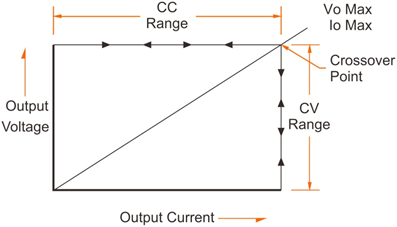FAQ
From more than 10 years experiences in OEM & ODM services, our sales team and technical team are always available to check and discuss your requirement details. We will make continuous efforts to improve capabilities of R&D, manufacturing and marketing to provide more and more reliable products and bring the best values to every customer.
A DC power supply is to supply voltage and current in constant
voltage (CV) or constant current (CC) mode within the rated output range. Such
working characteristics is called a constant voltage/constant current automatic
cross-over type. This permits continuous transition from constant current to
constant voltage modes in response to the load change. The intersection of
constant voltage and constant current modes is called the crossover point. Below
figure shows the relationship between this crossover point and the load.

In CV mode, a regulated output voltage is provided. The output voltage remains
constant as the load increases while the output current changes in response to
the load changes, up till the present current limit point is reached. At that
point, the output current becomes constant and the output voltage drops in
proportion to the further increases in load.
Similarly, in CC mode, crossover from the CC to CV mode automatically occurs
from a decrease in the load. A regulated output current is provided. The output
current remains constant as the load decreases while the output voltage changes
in response to the load changes.
A power supply with CV and CC operation mode can be operated in only one mode
according to load situation. The power supply is in CV mode when the actual load
is over the preset load capacity; and the power supply is in CC mode when the
actual load is below the preset load capacity.
When the power supply is connected to a big capacitive load, it
always causes increase to the output voltage in a power supply. The output
voltage may make fast increase to the Over Voltage Protection point. It may also
cause slow decrease when the output voltage is turned down.
To solve this problem, connect a power resistor in parallel to the output
terminals of the power supply; at the same time, connect a diode in serial
between output terminals and the load.

When an inductive load is connected to the power supply, it will
cause a reverse polarity induction electric motive force when the power supply
is turned on or off, or when preset the output voltage. The pulse noise caused
by an inductive load will also affect the power supply, especially when the
pulse noise has the same polarity with the output of power supply.
To avoid effect or damage to the power supply, connect a diode in serial between
the output terminals of power supply and the load; at the same time, connect a
power resistor and a capacitor in parallel to the load to make a R-C snubbed
circuit, which will significantly restraint generation of the noise.

When use the power supply to charge a battery, such as accumulator
and ni-mh battery, the recommended protection measures is to connect a diode
between the power supply and the battery. When the output electrolytic capacitor
of the power supply is charged, connecting a load (battery) may cause sparks.
This is normal. After the two of them get to equal voltage, the sparks will
disappear.

Even if the peak current of a pulse load, such as motor, bulb, DC-DC
or DC-AC converter module, does not exceed the rated current of the power
supply, it will also cause voltage drop or instability to the output.
A basic solution is to connect a inductor in serial between the power supply and
the load. Or, choose a power supply with higher rated current.
If the pulse circuit has a small pulse width or low peak current, another
solution is to connect a capacitor with large capacity. A reference to choose
capacity of a capacity is: 1000uF capacity to a 1A current.

When the power supply is connected to a load that will cause reverse
polarity current to the power supply output, the output voltage will increase,
because the power supply cannot absorb the reverse polarity current from the
load.
A solution is to connect a diode in serial between the output terminal and the
load; at the same time, connect a discharge resistor in parallel to the load to
absorb the reverse polarity current. When the reverse polarity current is a peak
surge, connect the large electrolytic capacitor in parallel to the two ends of
the load.
